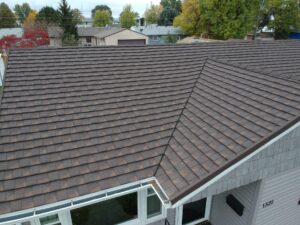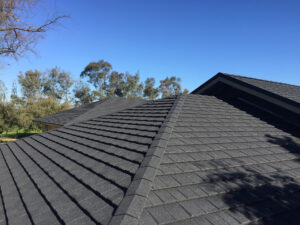
Roof replacements are rarely simple. Between labor shortages, tight margins, weather delays, and rising material costs, contractors are under more pressure than ever to get jobs done efficiently and right. For years, the standard approach to roofing replacements meant tearing off the old asphalt shingles, disposing of the debris, prepping the deck, and installing the new roof. It is a process that works but comes with its complications.
But what if there was a better way to cut time, labor, and hassle while still delivering a high-performance, attractive roof that lasts decades? That is precisely what more contractors are discovering with metal shingles installed directly over existing asphalt roofs.
There has been a surge in interest in this approach, particularly from contractors looking to stand out, increase profitability, and deliver long-term value to their customers. If you have ever walked off a jobsite thinking, “There’s got to be a more efficient way to do this,” metal-over-shingle might be the solution you’ve been looking for.
Understanding the shift
Traditionally, when homeowners or property owners reached the end of their asphalt roof’s life, contractors had one option: tear everything off and start fresh. This tried-and-true method is expensive, messy, and time-intensive—not just for contractors but also for the client.
More recently, contractors have begun offering metal roofing systems as an upgrade, particularly for customers concerned with longevity, storm performance, and maintenance. Thanks to product design and installation improvements, it is increasingly possible to install metal shingles over the existing asphalt roof without a complete tear-off, provided the deck and structure are still in good shape.
This is not cutting corners—it is smart, practical construction that makes sense in the right circumstances. For contractors, it offers a real business advantage.
Saving time without sacrificing quality
Every contractor knows that time equals money. The more time a crew spends on prep and tear-off, the longer the job drags out, the more risk of weather delays, and the fewer jobs can be booked during the busy season.
Installing metal shingles over an existing single layer of asphalt eliminates a significant part of the labor equation. There is no need to schedule a separate tear-off day, no dumpsters clogging the driveway, and no disposal costs to worry about. The crew can show up, prepare the underlayment, and start installing almost immediately. Those time savings add up quickly, especially on high-volume residential or light commercial jobs.
Importantly, customers notice. For homeowners or businesses trying to stay open during construction, fewer interruptions can make all the difference in how they view the experience and how likely they are to refer a contractor to others.
Technical know-how still matters

Of course, this method is not as simple as just slapping metal over shingles. Successful installation requires thoughtful inspection, preparation, and detailing.
First, it is critical to verify that the existing asphalt roof has only one layer and that the decking underneath is structurally sound. Any signs of rot, sagging, or moisture damage must be addressed before proceeding. A weak foundation will eventually compromise even the strongest roofing system.
Next comes the underlayment. It is recommended to use a high-quality synthetic or self-adhering membrane installed directly over the existing shingles. This layer acts as a moisture barrier and helps prevent abrasion from the underlying asphalt.
Ventilation is another area that cannot be overlooked. Improper ventilation can lead to trapped heat and moisture, which can shorten the life of the decking and the roof. During reroof jobs, it is the perfect opportunity to upgrade intake and exhaust ventilation to meet or exceed code.
Finally, the crew needs to know how metal shingles are installed. For example, Milan shingles use a concealed fastener system with interlocking panels, which means precision and layout matter. When done right, customers get a roof that performs like a standing seam and looks like a premium slate or shake without the weight or complexity of those materials.
When to recommend metal over shingles
Not every job is suitable for this method. Multi-layer shingle roofs, poor deck conditions, or local code restrictions may still require a tear-off. But metal-over-shingle is a compelling option for the right home—or light commercial property—with one layer of asphalt in good condition.
Many homeowners are surprised that metal shingles weigh less than asphalt and far less than concrete tile or slate. In most cases, overlaying does not add structural concern. When clients see a metal shingle roof’s curb appeal and longevity, paired with the faster installation timeline, they are usually more than ready to say yes.
We’ve seen this firsthand with contractors nationwide using Milan shingles to complete beautiful,
high-performance installs in half the time of a traditional reroof. One contractor in the Midwest recently said he was able to wrap up a 279 m2 (3,000 sf) roof in three days—including site prep—because there was no tear-off involved. The customer was thrilled, and the crew was back on the road faster, ready for the next job.
Why contractors are leaning in
This method provides options, whether navigating material shortages, trying to shorten install timelines, or just looking to stand out from the dozens of other roofers in the market, offering metal-over-shingle can help contractors hit all three goals.
It is not just about efficiency; it is about providing customers with a premium product that is sustainable, low-maintenance, and built to last. Contractors who offer that kind of solution become the ones people remember.
The smartest roof is not always the one that is torn off and started from scratch. Sometimes, the best roof is the one that builds on what’s already there—and makes it stronger.
Jessica Lowe Hall has over 27 years of experience in marketing, communications, and public relations. She helps brands tell their stories, connect with their audiences, and grow with purpose. Over the years, she’s led everything from campaign planning and content strategy to social media and branding, always focusing on creating work that truly supports the bigger picture for the business. She holds a Master of Science in Marketing with a specialization in digital marketing and a wide range of certifications from Google and HubSpot. Jessica is passionate about lifelong learning and keeping up with the ever-changing world of digital marketing. Today, she serves as corporate marketing manager at McElroy Metal, where she combines her years of hands-on experience with fresh thinking to lead creative, impactful strategies that make a difference.





